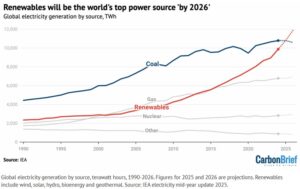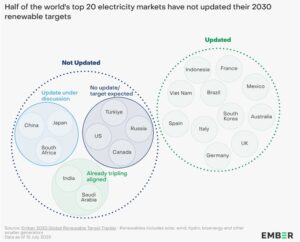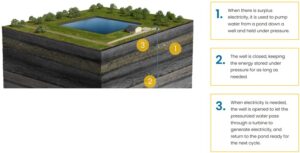Renewables to surpass coal this year, fake news and 21 for 1 return
In this issue:
Renewables to surpass coal this year (next at the latest)
That’s the prediction of the IEA in its Electricity Mid-Year Update. Global electricity demand is predicted to grow by 3.3% this year and 3.7% next, with 90% of that growth covered by new renewables. The report foresees increasing growth in nuclear and a decline in coal generation over the next two years.
Renewable targets stalling
While we regularly report on the continuing penetration of renewables, think tank Ember has put forward a different perspective on uptake. It is reporting national renewables targets are severely lagging the tripling of renewable capacity goal agreed at COP28. More than 120 countries signed the Global Decarbonisation Accelerator and only 22 have updated their 2030 targets since. A few are on target to triple without having revised their official target but most are simply falling behind.
21 for 1 return
Every $1 invested in identifying, disclosing and acting on climate mitigation returns an average $8 according to an analysis by CDP, with some companies seeing a return of $21 for each $1 invested. The analysis covered self-reported estimates of the financial impact of climate investments across nearly 25,000 companies in 2024. The analysis identified a multiplier effect for companies that act early and reports companies in Japan and Canada are most optimistic about their pay-offs.
Lies, damned lies and statistics
Not only an alternative perspective but a diametrically opposed conclusion to accepted scientific understanding has recently emerged from the US Department of Energy. It has just published A Critical Review of Impacts of Greenhouse Gas Emissions on the U.S. Climate. Authored by climate sceptics appointed by a fossil fuel entrepreneur, DOE Secretary Chris Wright, among other things it concludes:
- Increased levels of CO2 have a positive effect because they enhance plant growth;
- The Great Barrier Reef has recently rebounded (see below – Ed);
- The scientific literature overstates observed and likely future emission trends;
- Suggestions of increased intensity and frequency of severe weather events in the US are not supported by historical data;
- “aggressive mitigation policies could prove more detrimental than beneficial”; and
- “U.S. policy actions are expected to have undetectably small direct impacts on the global climate”.
The report has been widely criticised for cherry picking data and misrepresenting other authors.
We mention this, not because we wish to add credence to its outrageous conclusions but to alert people to the misinformation and fake news we now see from certain quarters that will, inevitably, provide fuel for inaction.
Record coral loss for Great Barrier Reef
Picking up on one of the conclusions above, the Australian Institute of Marine Science has just published its annual report on the state of the Great Barrier Reef. It reveals the 2024 bleaching event lead to the worst decline in coral since records began in two of the three regions surveyed, with losses of up to 70% on some reefs. Losses in the northern region were 25%, in the central region 14% and in the southern region over 30%. The survey covered a total of 124 reefs with 48% of them showing a decline and 42% no change. Only 10% showed increasing coverage.
Supporting future energy needs
The Australian government has just ramped up its support for its Capacity Investment Scheme (CIS). CIS is a revenue underwriting scheme aimed at supporting renewable generation and clean dispatchable capacity through decreasing investor risk. The newly revised targets are to support the build of 26 GW of renewable generation capacity and 14 GW of clean dispatchable capacity. Sounds like a good idea!
Yet another new storage technology
Quidnet Energy is offering a storage system that, it claims, stores energy for six months without loss. The technique, named geomechanical energy storage, is a flip of pumped hydro in that water is forced into permeable rock underground and held under pressure. When the energy is needed, the pressure is released and the water comes to the surface turning a turbine on its way. It runs through a closed system meaning less water is needed than standard pumped hydro and the stored water does not evaporate. The system is claimed to be 65% efficient compared with standard pumped hydro’s c.50%.
Did you know …..
The world’s longest lightning strike stretched for 829km? Analysis of satellite data by the World Meteorological Organisation (WMO) confirmed the strike stretched form eastern Texas to Kansas City, a notorious thunderstorm area. The strike took place on 22nd October 2017.



